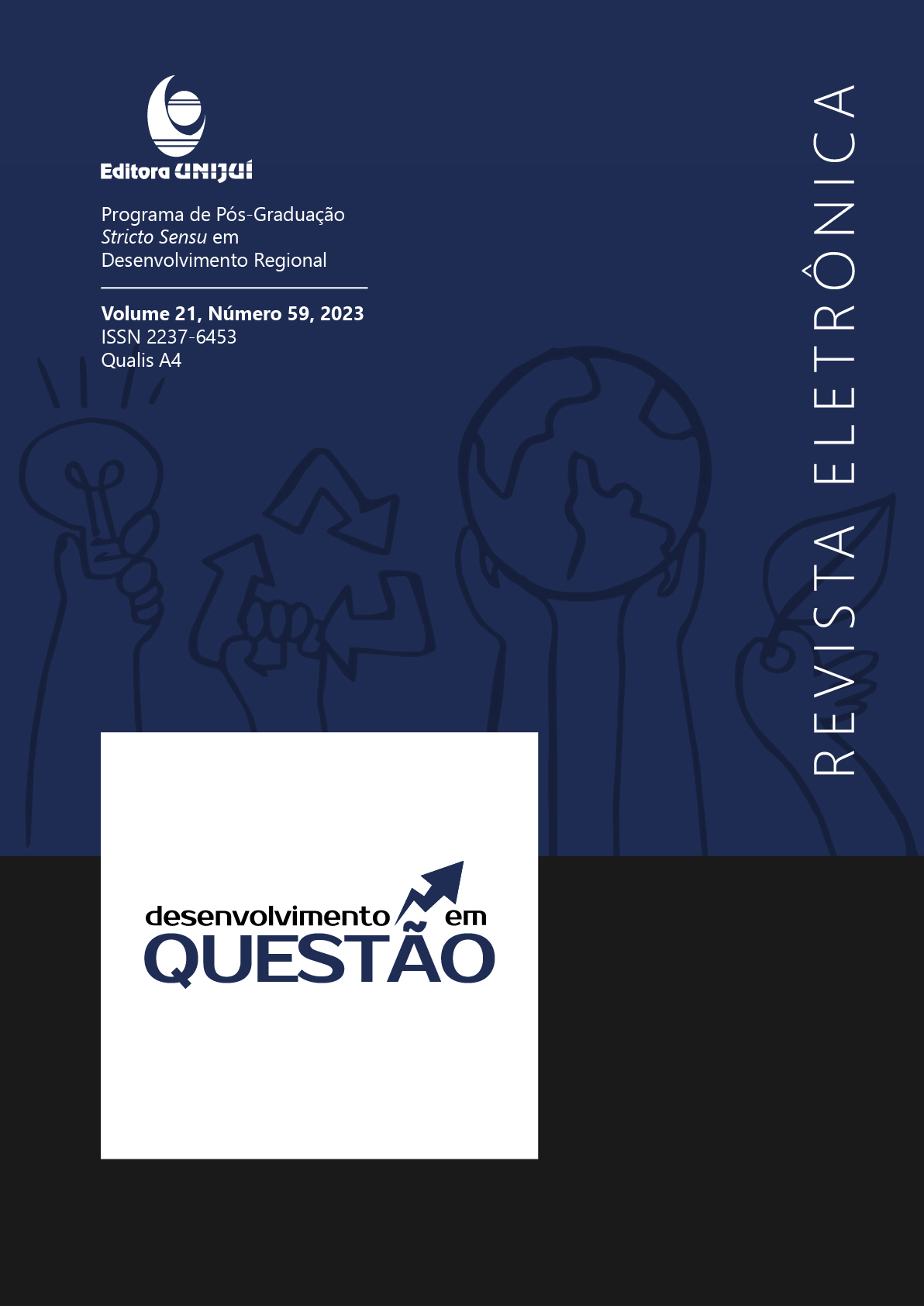Expansão do cultivo de soja no Rio Grande do Sul: Seu efeito sobre a gestão de riscos e composição agrícola
DOI:
https://doi.org/10.21527/2237-6453.2023.59.14086Palavras-chave:
Shift-Share, soja, agriculturaResumo
Este trabalho analisou os riscos de produção relacionados à expansão do cultivo de soja nas mesorregiões do Estado do Rio Grande do Sul no período de 2001 a 2020, com ênfase nas implicações desse processo para o mercado do seguro rural. Utilizando a metodologia Shift-Share foi possível observar o efeito escala e substituição da composição das áreas cultivadas nas diferentes regiões do Estado. Além disso, por meio do coeficiente de variação da produtividade da soja, foi construído um índice de risco relativo. Os resultados obtidos neste trabalho mostram uma expansão da área de soja que ocorreu principalmente sobre áreas de campos, onde 1,58 milhão hectares foram convertidos em áreas de soja, seguida pela cultura de milho, que teve área de 336 mil hectares convertidos. A região Sul do Estado, que é favorecida comercialmente pela presença do Porto do Rio Grande, está entre as regiões que tiveram o pior desempenho de produtividade e os mais altos índices de risco relativos para a cultura da soja. Em contraste, as mesorregiões Noroeste e Nordeste mostraram os menores valores esperados para o risco relativo, além de terem a menor proporção do prêmio convertido em indenizações.
Referências
ABDALA, K. O.; RIBEIRO, F. L. Análise dos impactos da competição pelo uso do solo no estado de goiás durante o período 2000 a 2009 provenientes da expansão do complexo sucroalcooleiro. Revista Brasileira de Economia, Rio de Janeiro, v. 65, n. 4, p. 373-400, 2011.
BALDI, G.; PARUELO, J. M. Land-use and land cover dynamics in south american temperate grasslands. Ecology and Society, on-line, v. 13, n. 2, 2008.
CONAB. Companhia Nacional de Abastecimento. Acompanhamento da safra brasileira. 2022. Disponível em: https://www.conab.gov.br/info-agro/safras. Acesso em: 12 out. 2022.
Embrapa. Embrapa e Monsanto desenvolvem soja tolerante a herbicida. 1997. Disponível em: https://www.embrapa.br/en/busca-de-noticias/-/noticia/17913602/embrapa-e-monsanto-desenvolvem-soja-tolerante-a-herbicida#:~:text=A%20Empresa%20Brasileira%20de%20Pesquisa,de%20soja%20tolerantes%20a%20herbicida. Acesso em: 01 mar. 2023
EMBRAPA. Empresa Brasileira de Pesquisa Agropecuária. Embrapa e Monsanto desenvolvem soja tolerante à herbicida. 2022. Disponível em: https://www.embrapa.br/busca-de-noticias/-/noticia/17913602/embrapa-e-monsanto-desenvolvem-soja-tolerante-a-herbicida. Acesso em: 10 out. 2022.
ESCHER, Fabiano; SCHNEIDER, Sergio; YE, Juingzhong. The agrifood question and rural development dynamics in Brazil and China: towards a protective “countermovement”. Globalizations, v. 15, n.1, p. 92-113, 2018.
FONTANA, A.; FREITAS, P. D. Solos arenosos: a nova fronteira agrícola brasileira. A Granja, v. 853, p. 80-81, 2020.
FORNAZIER, A.; SOUZA, P. M. de; PONCIANO, N. J. A importância do seguro rural na redução de riscos da agropecuária. Revista de Estudos Sociais, Cuiabá, v. 14, n. 28, p. 39-52, 2012.
FREITAS, R. E. Brazil’s agricultural expansion: main crops in matopiba. Revista de Política Agrícola, v. 31, n. 1, p. 70-85, 2022.
GONÇALVES, S. L.; SIBALDELLI, R. N. R. Riscos climáticos e viabilidade econômica da produção de soja no sul do Rio Grande do Sul. 2018. Disponível em: https://www.embrapa.br/busca-de-publicacoes/-/publicacao/1094511/riscos-climaticos-e-viabilidade-economica-da-producao-de-soja-no-sul-do-rio-grande-do-sul. Acesso em: 15 mar. 2022.
IBGE. Instituto Brasileiro de Geografia e Estatística. Produção agrícola municipal. 2022. Disponível em: https://sidra.ibge.gov.br/tabela/1612. Acesso em: 15 ago. 2022.
KODAMA, I. S.; LOURENZANI, W. L. Mudanças no uso da terra a partir da expansão do cultivo da cana-de-açúcar na região oeste do Estado de São Paulo. Desenvolvimento em Questão, v. 19, n. 55, p. 132-153, 2021.
KRUSKAL, W. H.; WALLIS, W. A. Use of ranks in one-criterion variance analysis. Journal of the American Statistical Association, v. 47, n. 260, p. 583-621, 1952.
LEMOS, G. D. S.; RIZZI, R. A expansão da soja no bioma pampa brasileiro e sua interação espaço-temporal com arroz e campo. Boletim Geográfico do Rio Grande do Sul, v. 35, p. 9-26, 2020.
LOURENZANI, W. L.; CALDAS, M. M. Mudanças no uso da terra decorrentes da expansão da cultura da cana-de-açúcar na região oeste do Estado de São Paulo. Ciência Rural, v. 44, p. 1.980-1.987, 2014.
MAPA. Ministério da Agricultura, Pecuária e Abastecimento. 2022a. Disponível em: https://www.gov.br/agricultura/pt-br/assuntos/riscos-seguro/seguro-rural. Acesso em: 15 ago. 2022.
MAPA. Programa de subvenção ao prêmio do seguro rural. 2022b. Disponível em: https://www.gov.br/agricultura/pt-br/acesso-a- informacao/dadosabertos. Acesso em: 17 ago. 2022.
MAPABIOMAS. 2022. Disponível em: https://mapbiomas.org/. Acesso em: 15 ago. 2022.
MENGUE, V. P.; SILVA, T. S. D.; FONTANA, D. C.; SCOTTÁ, F. C. Detecção de mudanças espaciais relacionadas à expansão da fronteira agrícola no bioma pampa. Revista Brasileira de Cartografia, Rio de Janeiro, v. 79, n. 1, p. 40-70, 2018.
MONTEIRO, J. E. B. d. A.; CUADRA, S. V.; BARIONI, L. G.; NAKAI, A. M.; MACIEL, R. J.S .; VICTORIA, A. F. D. O. D. d. C. Estudo de caso de um zoneamento agrícola de risco da produtividade climática (ZARCPro). Revista da Sociedade Brasileira de Agrometerologia, Passo Fundo, v. 27, n. 1, 2020.
OLIVEIRA, Gustavo de L. T.; SCHNEIDER, Mindi. The politics of flexing soybeans: China, Brazil and global agroindustrial restructuring. The Journal of Peasant Studies, v. 43, n. 1, p. 167-194, 2016.
OZAKI, V. A.; DIAS, C. T. d. S. Análise e quantificação do risco para a gestão eficiente do portfólio agrícola das seguradoras. Revista de Economia e Sociologia Rural, v. 47, n. 3, p. 549-567, 2009.
SCHNEIDER, M. Developing the meat grab. Journal of Peasant Studies, v. 41, n. 4, p. 613-633, 2014.
SILVA, L. I. d.; LEÃO, C.; PASQUALETTO, A. Área de ocupação da cana-de-açúcar no Estado de goiás e o efeito substituição em relação a outras culturas de abastecimento alimentar (2003-2012). Revista Bauru – Revista Brasileira de Assuntos Regionais e Urbanos, v. 1, n. 1, p. 21-35, 2016.
SILVEIRA, V. C. P.; GONZÁLEZ, J. A.; FONSECA, E. L. d. Mudanças no uso da terra depois do período de aumento de preço das commodities no Rio Grande do Sul, Brasil. Ciência Rural, v. 47, n. 4, 2017.
SOUZA, G. d. S.; ALVES, E.; GOMES, E. G.; GAZZOLA, R.; MARRA, R. Substituição de culturas: uma aboradagem empírica envolvendo cana-de-açúcar, soja, carne bovina e milho. Revista de Política Agrícola, v. 16, n. 2, p. 5-13, 2007.
TRENNEPOHL, D.; PAIVA, C. A. N. A importância da sojicultura para o desenvolvimento da região noroeste do Rio Grande do Sul. Ensaios FEE, v. 31, n. especial, p. 741-778, 2011.
WILCOXON, F. Some uses of statistics in plant patholofy. Biometrics Bulletin, v. 1, n. 4, p. 41-45, 1945.
WILKINSON, John; WESZ JUNIOR, Valdemar João. Underlying issues in the emergence of China and Brazil as major players in the new South-South trade and investment axis. International Journal of Technology Management & Sustainable Development, v. 12, n. 3, p. 243-260, 2013.
Downloads
Publicado
Como Citar
Edição
Seção
Licença
Copyright (c) 2023 Desenvolvimento em Questão

Este trabalho está licenciado sob uma licença Creative Commons Attribution 4.0 International License.
Ao publicar na Revista Desenvolvimento em Questão, os autores concordam com os seguintes termos:
Os trabalhos seguem a licença Creative Commons Atribuição 4.0 Internacional (CC BY 4.0), que permite:
Compartilhar — copiar e redistribuir o material em qualquer meio ou formato;
Adaptar — remixar, transformar e criar a partir do material para qualquer fim, inclusive comercial.
Essas permissões são irrevogáveis, desde que respeitados os seguintes termos:
Atribuição — Atribuição — os autores devem ser devidamente creditados, com link para a licença e indicação de eventuais alterações realizadas.
Sem restrições adicionais — não podem ser aplicadas condições legais ou tecnológicas que restrinjam o uso permitido pela licença.
Avisos:
A licença não se aplica a elementos em domínio público ou cobertos por exceções legais.
A licença não garante todos os direitos necessários para usos específicos (ex.: direitos de imagem, privacidade ou morais).
A revista não se responsabiliza pelas opiniões expressas nos artigos, que são de exclusiva responsabilidade dos autores. O Editor, com o apoio do Comitê Editorial, reserva-se o direito de sugerir ou solicitar modificações quando necessário.
Somente serão aceitos artigos científicos originais, com resultados de pesquisas de interesse que não tenham sido publicados nem submetidos simultaneamente a outro periódico com o mesmo objetivo.
A menção a marcas comerciais ou produtos específicos destina-se apenas à identificação, sem qualquer vínculo promocional por parte dos autores ou da revista.
Contrato de Licença (para artigos publicados a partir de 2025): Os autores mantêm os direitos autorais sobre seu artigo, e concedem a Revista Desenvolvimento em Questão o direito de primeira publicação.











